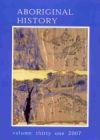 6226539212483389006.jpg
6226539212483389006.jpg
 6226539212483389006.jpg
6226539212483389006.jpg
'With the possible exception of Reg Saunders who was the only Aborigine to be promoted to commissioned rank in the Australian forces during the Second World War, those who gave outstanding service in defence of their country in Australia's numerous wars this century, have been overlooked. Nevertheless, many of the Aboriginal and Islander participants in Ausmalia's defence effort did demonstrate a particular klnd of heroism; that despite the disadvantages forced upon them by the dominant white society, once given the opportunity that often comes with war, they showed high levels of determmation, achievement, skill and leadership. One such man to emerge from the Second World War was Leonard Waters. This article profiles Leonard Water's journey, providing background to Len's involvement with the Royal Australian Air Force.' (Source: Abstract)
'An oral account is presented relating to the nine Aboriginal and Thursday Island soldiers' that the author served with. They were good soldiers, two gave their lives for this country. One was awarded a posthumous Mentioned in Despatches. Finally, they were proud of their regiment and their regiment was proud of them.' (Source: Abstract)